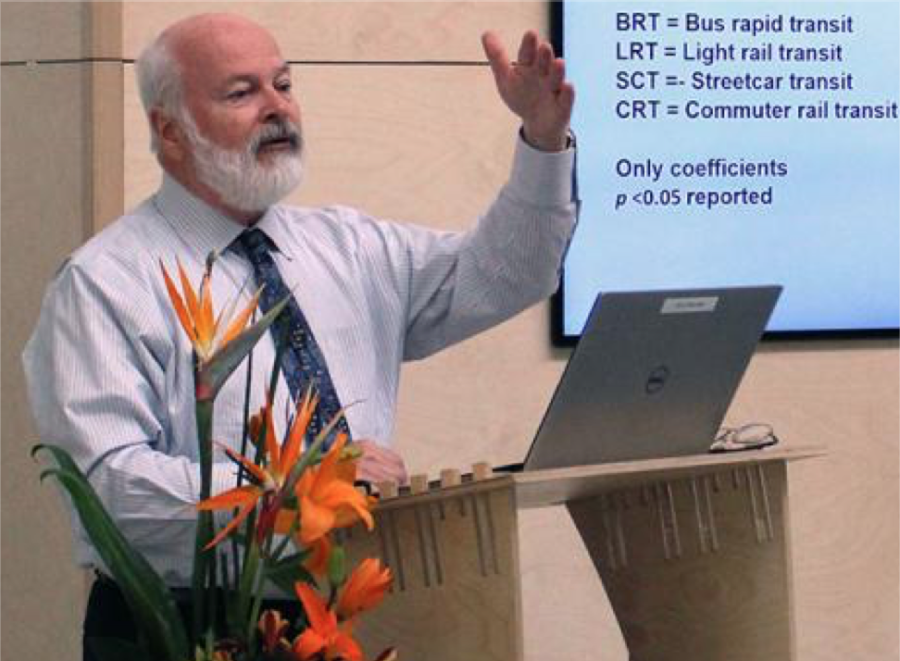A study from a University of Arizona professor in the College of Architecture, Planning and Landscape Architecture predicts that millions of homes owned by baby boomers and Gen Xers will become unsellable due to demographic and preferential shifts among millennials and Gen Zers in the next couple of decades.
The Daily Wildcat interviewed Arthur Nelson, a professor of urban planning and real estate development at the UA, who authored the study to find out more about his research and its implications.
RELATED: Coalition of Black Students and Allies marches to decriminalize Black lives
Daily Wildcat: What led you to conduct this study in the first place?
Arthur Nelson: I’m one of maybe two or three people in the country that look long-term to the effect of changing demographics and changing economics on future housing demand and future land use demand. … I’ve been doing this work since I worked for [the U.S. Department of Housing and Urban Development] for a year on some kind of a release back in 2000, so I’ve been at this sort of genre of research for about 20 years now.
That got me into looking — I’m always looking at least 30 years ahead. I got numbers looking to the year 2100, but I’m looking to 2050, 2040 to see where we are now, where we’re headed and the nature of change that we have to be prepared for. Most local governments, most decision makers, our politicians don’t know the future — not that anybody does — but we know more about the future than a lot of people do … so my role, as is a few others, is to show how demographic changes will change housing demand and change land use patterns and change the nature of what government needs to do.
DW: Would you be able to summarize for me in layman’s terms what this study showed?
AN: The study looks at different generations. We’ve had, since World War II, five or so generations of people: the so called baby boomers, Gen X born between 1965 and 1980, Gen Y born between 1981 and 1997 or so and Gen Z born in the late 1990s and just got finished being born two or three years ago, depending on who you talk to.
Each generation has its own housing demand characteristics, both as they age and as their preferences change. That’s the point of this paper, though sort of in a long-winded way as academics will do. I looked at this huge group called baby boomers. We are still the most influential generation on land-use patterns and housing demand ever in this nation’s history. At first, we were the ones who were the reason that the suburbs started, because the cities had no room to accommodate massive numbers of families with children. The suburbs became the way in which we could meet that housing demand, and it worked pretty well, frankly. But as the boomers move on through their age groups, their housing demand changes from a large home and large lot to a smaller home, maybe a townhouse, a condo, assisted living and so forth.
Eventually, boomers who own homes by the 10s of millions are going to want to sell their homes. Well, to whom will they sell their homes? The generations behind them are a lot smaller. The next generation is Gen X, but they’re kind of tagging along in the same age cohort as the boomers. As the boomers start selling their homes, so will Gen X householders soon after. So you basically have the double whammy of very large generations of baby boomers and the smaller one, Gen X, but still combined being a huge part of the housing market.
They’re going to be trying to unload their homes at about the same time … the only ones out there buying would be the millennials and then the younger Gen Z, but there won’t be enough of them to buy all the homes that the baby boomers and Gen X want to sell.
That’s one problem: excess supply relative to the demand. The next problem is that the Millennials and Gen Z households — they don’t want the large home on the large lot in the distant suburbs. Certainly some do, but they don’t want that to the extent that that was produced in the 1960s, 70s, 80s, 90s. … They’re looking for something closer in, a little higher density, but not high rise. They’re looking for townhouses. They’re looking for smaller homes and smaller lots and they’re looking for walkable communities … they want to have a relatively short bicycle ride to places.
Again, not all of them, but we’re talking at least half, maybe to a third of them, whereas the baby boomers, when they were raising their own children, couldn’t care less about walkable communities … and so here we have the baby boomers and Gen Xers with larger homes in larger lots in distant suburbs trying to sell homes to millennials and Gen Zers who want smaller homes on smaller lots, maybe attached homes, that are walkable and bikeable to places. There’s the mismatch going on that will lead to an excess number of homes trying to be sold relative to the demand.
Then, I also get into the geographic disparities. It’s not going to be an issue so much in Tucson, Phoenix, Denver or some of the other growing metropolitan places. One thing growth does is sort of fix mistakes. Maybe people who bought larger homes on larger lots 30 miles from downtown Tucson will sell their home because they’ll reduce the price low enough to where some people will buy the home and that’s that. But what if you’re in Buffalo or Rochester or the exurbs of Chicago or Detroit?
In most metropolitan areas in this country, the supply of potential baby boomer sellers will vastly exceed the supply of people wanting to buy those homes because of the lack of growth. There’s a map in the report showing, by county in red, where those counties are losing population. We have the age dynamic going on, we have the preference dynamic going on, and we have the growth dynamic going on, and so I try to sort of plow through all of those things at the same time and come up with a way for them to address the concerns I have about the millions of seniors trying to sell their homes between now and 2038.
RELATED: Report: Arizona coaching legend Lute Olson passes away at age 85
DW: Do you know why Millennials and possibly Gen Zers have this preference for smaller and less dense areas?
AN: Let’s not overgeneralize, because many millennials and many Gen Zers will want a larger home and a larger lot away from people. But we are seeing that more will want something that’s more manageable for lot-size and that’s more manageable for house-size. For one thing, their household size will be smaller.
They’re going to have one or two children, not the three or four when I grew up. They also have less income. We still have a situation in the U.S. where in real dollar terms, the wages of 2020 are still lower than the wages of 2000. I don’t see that changing anytime soon. We have lagging wages in real dollar terms, we have changing demand structures, and so younger households are looking for certainly their own home, but not a large lot and not a large home, but especially a home that is accessible, ideally walkable to stores, restaurants, the park and so forth.
DW: In light of these shifts, do you see the expansion of urban areas, urban outskirt areas and more houses being converted into multiple family residences or even apartments?
AN: What I see in the data is that millennials and probably Gen Zers are having fewer children. When they do have children, they have them later in life, which means that the couples get settled into someplace that is more mature, like the cottages or the townhouses and the condos with the shops, restaurants and parks nearby, and so they’re used to that. Then they have children … and they will tend more than in the past to raise their children in their condo, in their townhouse, in the small home, in the same neighborhood where they’re established with their own friends, with their social networks, and walkable places that they are used to. That’s one dynamic going on.
Another dynamic going on that we see among the new housing being built in the suburbs is that the market is for smaller homes in smaller lots in walkable planned communities. We’re seeing suburban subdivisions being built with walking paths, bicycle paths and connected to nearby shops, nearby restaurants and so forth. Now that probably isn’t happening as much as it should happen because I think the market demand is pretty robust, but it’s happening much more now than it did 20, 30, even 10 years ago.
DW: How has the pandemic affected any of the Great Senior Short Sale? Has it had any effect at all?
AN: I would say no effect at all because it’s been too short. If the pandemic lasts two or three or four years, I don’t know exactly what we’ll see because, on the one hand, some will say that it will push people out into rural areas to be safe from [COVID-19], but I don’t think so because even though you might be able to work from home, and even though you might want to be away from people, we’re still social creatures. We’re still near enough to people to socialize to some extent. And, this is still going to be a short term situation.
Everything I’m reading is that we’ll have vaccines out next year, by middle next year or a little later, the U.S. population will be inoculated and then have people go back to more or less what they had before. Let’s keep in mind that human beings are social creatures with short memories people will want to be together and they will come back together after [COVID-19].
Will [COVID-19] have an effect in the long-term? No, provided we have the vaccines promised. Will there be a long-term effect if [COVID-19] lasts a long time? Certainly.
RELATED: University of Arizona employee stabbed in Student Union
DW: Tell me more about your policy recommendations for this projected trend.
AN: We pretty much know which counties in the U.S. aren’t going to grow and we pretty much know why. If we know what is not going to grow and why, let’s find ways now to help those people live in those counties and cushion the economic blow to them.
One direct way would be to offer them money to sell their homes to whatever federal agency and then they could move. The federal agency would raise the homes, tear them down and reassemble land into larger open-space areas. But that’s just one solution.
Another solution would be, where there is a market, facilitating the purchase of homes from seniors to groups who would turn those homes into rental homes, because that is the future demand for many metropolitan areas. I think the point is that we should start a conversation now to address the reality of what’s going to happen and the alternatives to soften the blow of those people by the millions who will be adversely impacted by that change.
You can view Nelson’s study, “The Great Senior Short-Sale or Why Policy Inertia Will Short Change Millions of America’s Seniors”, published in the Journal of Comparative Urban Law and Policy, here.
Follow Kristijan Barnjak on Twitter









